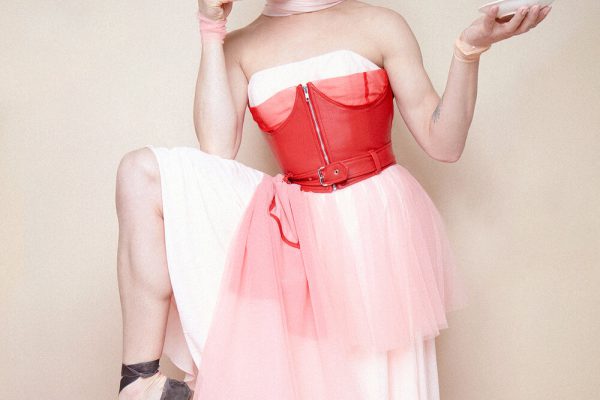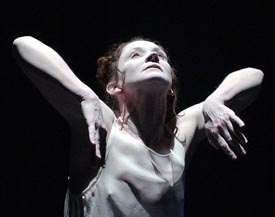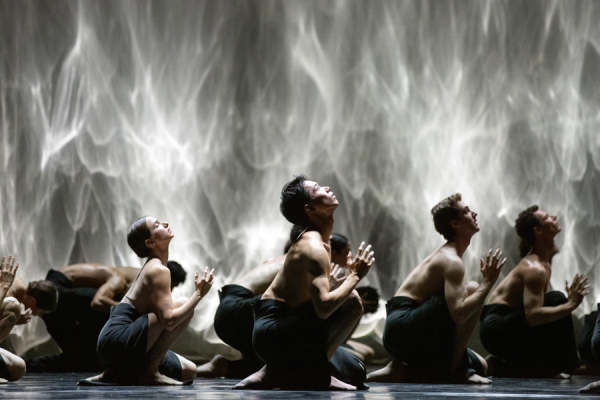Leap day reliably recurs once every four years, but the National Ballet’s mixed program Angels’ Atlas with Chroma & Marguerite and Armand was an even rarer temporal event in our journey around the sun. When else will you get to see the world premiere of the Canadian hotshot choreographer Crystal Pite’s newest work back-to-back with the classical ballet superstar Greta Hodgkinson’s swan song? The February 29 opening of this eccentric program was an evening of stylistic whiplash never to be seen again.
The evening program saved best for last with Crystal Pite’s Angels’ Atlas, a gripping premiere and her second ballet for this company. Despite the black stage and dark costumes by Nancy Bryant, Atlas is a luminous work. Jay Gower Taylor and Tom Visser’s captivating reflective light designs open the ballet, pouring down from above and illuminating the ensemble. There is no accompanying orchestra; instead, Atlas is scored by resonant recordings of sacred music both new and old. The choral vocalizing is immediately evocative of the divine, and there is something otherworldly in seeing Pite’s thirty-six-person ensemble clutching head and heart in harmonized anguish, yearning for each other with desperate arms extended and at last converging in united stillness.
Of several pas de deux in Atlas, the dynamic pairing of Siphesihle November and Hannah Galway is the standout, a narrative of combat and connection. An especially striking sequence is set to Morten Lauridsen’s O Magnum Mysterium; as November mourns Galway’s death, the ensemble falls in a mesmerizing domino pattern, marrying the death of the individual to the death of the collective. And when one rises, so do they all, reuniting with a communal pulsing action. Pite’s ethos is clear throughout Angels’ Atlas: she’s concerned with the struggle and glory of shared humanity. Her ballet closes on a simple yet sacred image: November and Galway embrace as the reflective light rises to the heavens.
By contrast, Wayne McGregor’s Chroma is an unsettling twenty-three minutes of aggressive contemporary ballet. Where Angels’ Atlas shines in darkness, designer John Pawson has laid Chroma’s stage bare — glaring white — for the ten-person ensemble’s writhing and twitching. The ballet is an exploration of sheer bizarreness in movement, and its score of harsh brass and sawing strings (by the composer Joby Talbot with music by The White Stripes) creates sustained tension throughout. It’s a precise chaos: the dancers echo the dissonant music, transitioning from insect-like wriggling to robotically halting body rolls into violent, provocative lifts.
There’s poetry in McGregor’s sharp choreography; he transforms classical ballet into acrobatic dynamite. But while the ensemble performs with metronomic precision, Chroma often feels dehumanizing. Pawson’s set is more a display case than a stage, and Moritz Junge’s flesh-toned, unisex costumes render the ensemble mostly homogenous. There are moments of unexpected intimacy cast in blue by Lucy Carter’s lighting, making the dancers briefly seem more than performative bodies, suddenly human, tender and frail. But unforgiving white light returns as the orchestra crescendos and the ensemble matches triumphant percussion with renewed vigour. They turn away from the audience as the lights snap off, and Chroma ends as disruptively as it begins. It’s a strong testament to McGregor’s sense of the dystopian, boding well for his adaptation of Margaret Atwood’s MADDADDAM trilogy premiering at The National Ballet of Canada next season
The classical romance Marguerite and Armand, adapted from a Dumas love story, is out of place among the evening’s contemporary pieces, but it’s a sufficient showcase for Greta Hodgkinson, retiring after thirty years with the National Ballet in this company premiere. The piece was originally created by Sir Frederick Ashton for Margot Fonteyn and Rudolf Nureyev in 1963 and has been infrequently performed since then, with good reason: its draw as a ballet relies mostly on the star power of its leads, not its artistic merit. Still, Hodgkinson excels as Marguerite, capturing the excitement of first love as she falls for Armand, danced passionately by Guillaume Côté.
Yet despite the leads’ chemistry and charm, the dated Marguerite and Armand feels awkward in its stagey melodrama. Ashton’s choreography does its best with a less than ideal score — Franz Liszt’s Piano Sonata in B minor, which is not written for dance — and reaches its height with a concluding lift, the dying Marguerite appearing to fly in Armand’s arms. It’s a soaring end to Hodgkinson’s storied career, and when he lays her down, Côté’s anguished breath resounds throughout the theatre. The true romance of the moment almost redeems the rest of the ballet’s sentimentality.
Marguerite and Armand’s indulgent look at love may be the counterpoint in this program to Chroma’s inhuman coldness, but Angels’ Atlas provides the transcendent medium between the two: a compelling display of both the impressive strength of the dancers and the ineffable mystery of human experience. Pite has offered Toronto audiences a fleeting glance into the numinous — and, like leap day, it won’t be around again anytime soon.





